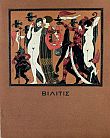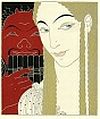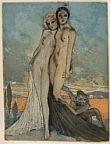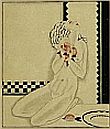 During the late nineteenth century, if you desired to be in touch with the new movements in art, it was indispensable to turn to French literature. It was an especially favorable choice to refer to the particular productions of a brilliant young author, M. Pierre Loüys, who had acquired wide popularity and whose work had been translated into German, Czech and Swedish. His unique style was essentially different than that of every poet in French literature, because it was unflinchingly saturated in intense Hellenism rather than adhering to the more common influence of Latin, as the majority of Loüys’ colleagues chose to do.
During the late nineteenth century, if you desired to be in touch with the new movements in art, it was indispensable to turn to French literature. It was an especially favorable choice to refer to the particular productions of a brilliant young author, M. Pierre Loüys, who had acquired wide popularity and whose work had been translated into German, Czech and Swedish. His unique style was essentially different than that of every poet in French literature, because it was unflinchingly saturated in intense Hellenism rather than adhering to the more common influence of Latin, as the majority of Loüys’ colleagues chose to do.
Loüys had quite the sense of humor, which was evidenced with his 1894 publication of Chansons de Bilitis, prose poems ‘d’amour antique,’ so-called translations from the Greek of a courtesan, poetess contemporary with Sappho. It in fact proved to be one of the most successful literary hoaxes of the 19th-century, deceiving even the best of scholars of the time. The introduction of the book describes the poetess, Bilitis, as a Greek woman whose 143 prose poems were discovered on the walls of a tomb in Cyprus. Bilitis actually turned our to be none other than Loüys himself, who went as far as listing some of the poems in Greek to prove authenticity.
In the following years a great deal of artists inspired by Chansons de Bilitis, drew homage on the theme of lesbian love that decorated the pages of rare erotic books. George Barbier, Louis Icart, Édouard Chimot, Mariette Lydis, Sylvain Sauvage, Paul-Emile Becat, P. Albert Laurens, Jean Berque and many more illustrated the sensual poetry in a number of publications. The theme proved extremely popular with Art Deco artists, such as Barbier and Icart, and it continues to be attractive to new artistic talent more than one hundred years later.
 In 1922, George Barbier, engraved on wood forty-two illustrations that were published by Pierre Corrand in a limited edition of 133 copies. The drawings were colored by Schmied and signed by Barbier whose brilliant career as an illustrator began in 1911. This book is considered to be his best early work that ranks as one of the Art Deco’s most exquisite works. It is an extremely rare book commanding over 20,000 USD.
In 1922, George Barbier, engraved on wood forty-two illustrations that were published by Pierre Corrand in a limited edition of 133 copies. The drawings were colored by Schmied and signed by Barbier whose brilliant career as an illustrator began in 1911. This book is considered to be his best early work that ranks as one of the Art Deco’s most exquisite works. It is an extremely rare book commanding over 20,000 USD.
 In 1925, Édouard Chimot drew his interpretation of the Bilitis theme with four states of 12 original etchings including the final state in color. It was published by Editions d’Art Devambez in total release of 640 copies. It is a unique illustrated book of the twentieth century that is currently priced around 3,000 USD for copies on Japanese paper.
In 1925, Édouard Chimot drew his interpretation of the Bilitis theme with four states of 12 original etchings including the final state in color. It was published by Editions d’Art Devambez in total release of 640 copies. It is a unique illustrated book of the twentieth century that is currently priced around 3,000 USD for copies on Japanese paper.
 In 1927, Sylvain Sauvage delivered his impression of the theme with 34 compositions – woodcuts that were hand-colored by Pierre Bouchet. Mindful of harmony between typography, illustrations and ornaments, Sylvain Sauvage became his own publisher in 1925 and later the director of École Estienne, Graduate School of Arts and Printing Industry. The publication was a limited edition of 287 numbered copies and can currently be purchased for around 1,000 USD.
In 1927, Sylvain Sauvage delivered his impression of the theme with 34 compositions – woodcuts that were hand-colored by Pierre Bouchet. Mindful of harmony between typography, illustrations and ornaments, Sylvain Sauvage became his own publisher in 1925 and later the director of École Estienne, Graduate School of Arts and Printing Industry. The publication was a limited edition of 287 numbered copies and can currently be purchased for around 1,000 USD.
There is no doubt that these books are extremely scarce. The number of copies originally produced dictates that there is a very limited supply. If the current pricing is a true reflection of the state of the market, then one can easily see that they are not in high demand. Why is Art Deco’s erotica not as popular in today’s times?
{ 1 comment… read it below or add one }
Corrections to Bookworm’s article on Bilitis: Pierre Corrard’s Widow published Bilitis in 1922. Corrard was already deceased. Barbier did not do the engravings on wood only the drawings. The engravings were done by Schmied. The execution of the book was done by Pierre Bouchet and each page was pressed by hand in the antique manner in his studio. Barbier’s drawings were doneearlier in 1914 but the book was put on hold because of WWI. Barbier also did a unique copy of Bilitis in 1910 with all the illustrations done by hand. A 1929 version was Barbier’s last and was done for the friends of Bilitis in an edition of 25…
{ 1 trackback }